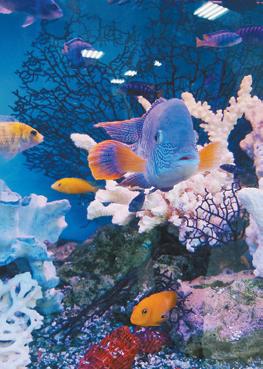
6 minute read
ACHILLES
Achilles Tendon Relief
By Eric Winder, D.C.
Advertisement
Apainful Achilles tendon can cramp your lifestyle. Achilles tendinitis leads to pain and inflammation in the large tendon that connects your calf muscles to the back of your heel. While traditional treatments of rest, physical therapy and antiinflammatory medications can provide relief, for many, the issue still persists, or the relief does not last once you return to a regular lifestyle. Fortunately, problems with this tendon can often be relieved when underlying causes are addressed in the connective tissue called fascia.
Most cases of Achilles tendinitis are not caused by a specific injury. The traditional view is the cause is most often unknown, but there are also many cases attributed to repetitive stress by activities such as running or jumping. In my practice, I find these cases—whether in casual walkers or running athletes—can usually be traced to problems in fascia which is a fabric-like fibrous tissue found throughout the body.
Structural Fabric
Fascia covers other tissues, like muscle and bone, and connects them to other tissues. This “structural fabric” is found everywhere in the body and holds special nerve endings that sense pressure and tension. When we move, these nerve endings send signals that tell our brains where our body parts are in space.
This information gives us the ability to have coordination, balance, joint alignment and muscular stability. A restriction or distortion in the fascia in one area of the body can confuse those signals with another area, resulting in subtle postural weakness
No Beach Walks
Recently, a patient I will refer to as Stan came to our office, looking for help with tendinitis that had caused him heel pain for years. While he could walk normally for short distances, he would start to limp after more than ten minutes of walking. The extra muscle challenge of walking on sand made beach walks with his wife out of the question.
Physical therapy with ultrasound, stretching and strengthening would help to relieve acute pain flares, but no treatment had resolved the problem. He heard that we took a whole-body approach to find the underlying causes and, therefore, wondered if we could find an explanation for his problem.
Stan’s initial examination at our office showed restriction of the fascia near the Achilles tendon and in the muscle just above it. More importantly, there were tight restrictions in the fascia of certain hip and lower back muscles that triggered uneven muscle tension in the hip and thigh on his painful side. This instability caused a deep tension in his calf muscle that resulted in excess stress on the Achilles tendon. Stan could stretch the calf for temporary relief, but the calf tension would not leave entirely since it was triggered from another part of the body.
Finding Relief
Treatment for Stan focused on hands-on therapy to release restrictions in the lower back and hip area, then eventually in the calf muscle also. Low level laser therapy was also applied to the Achilles tendon itself to improve tissue health and decrease pain and inflammation. After several weeks of treatment, he was able to resume two-mile walks for exercise around his neighborhood with only mild discomfort. By the time his treatment was finished, Stan could walk in the sand and enjoy the beach with his wife.
There were two keys to successfully relieving Stan’s pain. The first was realizing the importance of fascia restrictions in creating muscular imbalance and pain in the body. The second was looking beyond the area of pain and assessing his entire body framework to locate the true underlying sources of the problem.
No two cases of Achilles tendinitis are exactly the same. However, I find that using the above principles leads to successful treatment almost every time. This is true even when there is a bone spur, bony enlargement of the tendon attachment (Haglund’s deformity) or even scar tissue from surgical repair of the tendon. Therapies that treat and release restriction from fascia can offer remarkable results when treating Achilles tendinitis. I recommend that anyone suffering from this type of pain consider seeking out a practitioner who can evaluate for potential problems in the fascia, using a whole-body approach.
Eric Winder, D.C., uses gentle manual therapy and rehab techniques, without forceful manipulation, to help patients with a wide range of pain and injury problems. For more information, call 941957-8390 or visit Gentlebay.com. Dr. Winder’s offices are located in Sarasota and Osprey.
global briefs Fishy Business
Saving Coral Reefs Worldwide
The International Coral Reef Initiative (ICRI) has urged governments to take action to save the planet’s remaining coral reefs and their attendant fish populations, pyvovarova yevheniia/Unsplash.com because collective human impacts are leaving fewer places untouched, with only 15 percent of the Earth’s land mass formally protected and global biodiversity declining at an unprecedented rate. To that end, a new online data platform, MERMAID (DataMermaid.org) helps scientists and management officials collect, organize and disseminate data on reef fish biomass and diversity, as well as the cover of hard corals, fleshy algae and other benthic groups—all identified by ICRI as key indicators of coral reef health, integrity and function.
The newly published 5th Global Biodiversity Outlook and other sources endorsed by the Intergovernmental Panel on Biodiversity and Ecosystem Services clearly indicate that governments are failing to meet existing global targets for biodiversity and that critical ecosystems like coral reefs will be altered to the point that the biodiversity they harbor, and the services they provide, will be irreparably damaged. Currently, only 2.5 percent of the world’s reefs are being actively protected.

Caribbean Offshore Drilling Threatens Florida Beaches
The Britishowned Bahamas Petroleum Company (BPC), under a license from the Bahamian government, has begun exploratory oil drilling as deep as 18,000 feet in an area southwest of Andros Island and 150 miles from South Florida. Eighteen members of the U.S. Congress, including the entire South Florida delegation, have warned Bahamian Prime Minister Hubert Minnis of the potential for severe, even catastrophic impact if a spill occurs.
BPC has made assurances that the exploratory well will be sealed and never used again after it completes its exploratory drilling, and supporters of the project say that the process is closely regulated and accidents are rare. Still, Floridians remember the 2010 Deepwater Horizon spill in the Gulf of Mexico that leaked an estimated 164 million gallons of oil and caused billions of dollars in economic and environmental damage. Even a minor accident that leads to a small oil spill could cost the state millions of dollars and disrupt tourism and businesses. Casuarina McKinney-Lambert, executive director of the Bahamas Reef Environment Educational Foundation, says that delicate areas of the Florida Keys would be particularly vulnerable to a spill.

Hot Stuff
The Benefits of Renewable Geothermal Energy
Due to the ongoing decay of radioactive elements in the Earth’s core, temperatures 4,000 miles below the surface can reach 10,800° F. The molten magma we call lava carries enormous heat to the surface. But despite its enormous potential, geothermal energy supplied just 0.4 percent of U.S. electricity in 2019. In California, the perimeter of the inland Salton Sea lies several thousand feet above a mineral-rich cauldron of hot water that powers 10 geothermal plants. The state has emphasized wind and solar power while neglecting the development of geothermal plants, despite possessing our most productive geothermal fields. The Massachusetts Institute of Technology estimated in 2007 that releasing just 2 percent of this untapped resource in sites around the country could supply 2,000 times our overall primary energy needs without needing any improvements in drilling technology. While the first geothermal plants in the 1960s drained reservoirs of their steam or water, binary plants—a new design from the 1980s—allow operators to extract the heat while maintaining the generating potential. Between 2006 and 2019, the U.S. Department of Energy spent only $1 billion on geothermal technology due to falling coal prices, a fraction of what was spent on fossil fuels and solar investment.









